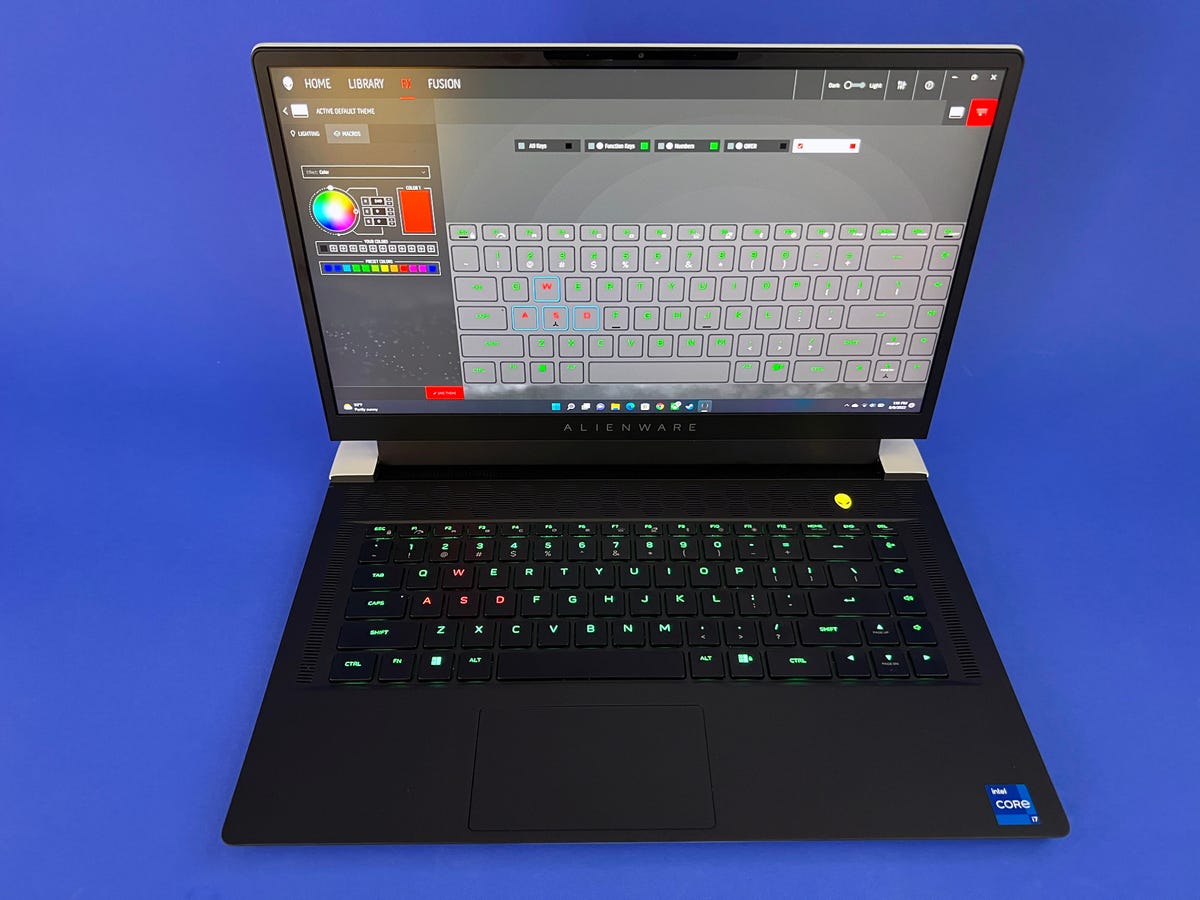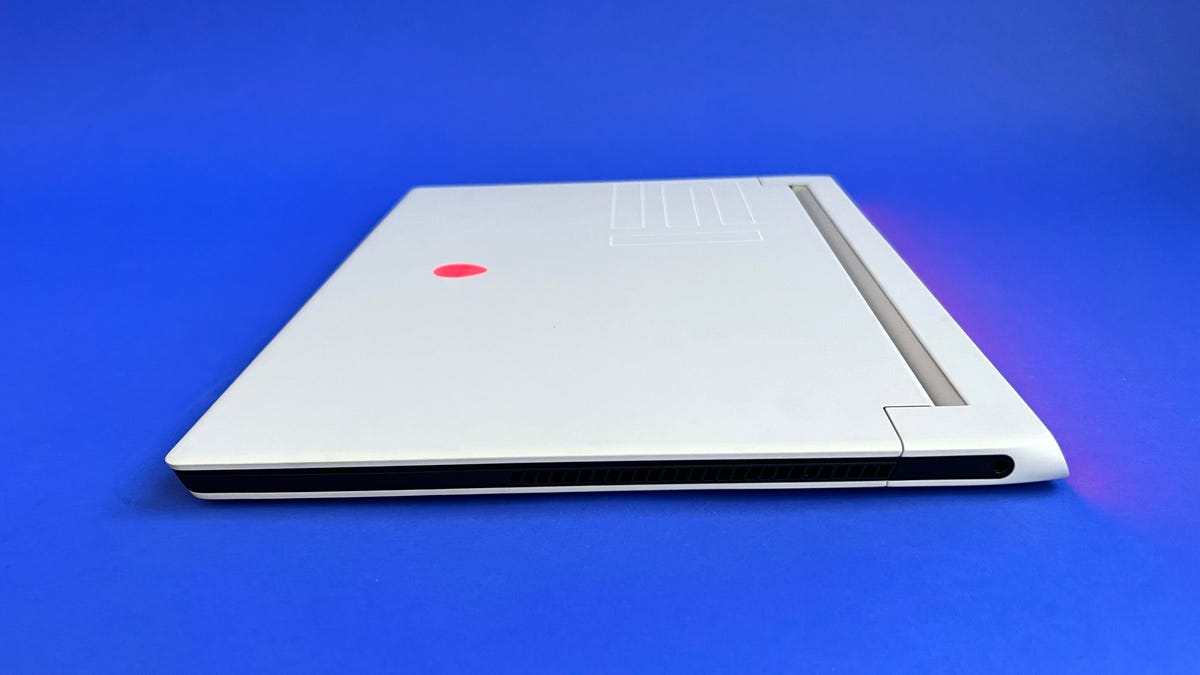If you want your gaming laptop to be thin, it’s going to run hot. That’s just the physics of packing a powerful CPU and GPU into a 15.7mm-thick body. And since we’ve managed to make gaming laptops reasonably small, semistylish and powerful enough to shame even the latest game consoles, heat is really the last frontier that no one has cracked.
On the small and stylish front, I can safely say the Alienware x15 R2 is one of the more attractive gaming laptops I’ve ever tested, and shows just how far we’ve come from the giant cement blocks of yesteryear. My spouse, who has worked in games and games media for much of the past 20 years, said it was one of the only gaming laptops that wasn’t aesthetically offensive to her, so trust me, that’s high praise.
Like almost all Alienware and Dell computers, the x15 R2 (the second major revision of the current 15-inch x15 line) offers a wide array of configuration options, starting at $1,999 and going up from there. This review sample was $2,559, and highlighted by a 2.3GHz Intel Core i7-12700H CPU, Nvidia GeForce RTX 3070 Ti graphics card and 2,560×1,440 display with a decent 240Hz refresh rate. It also includes 32GB of RAM and a 1TB SSD.
You can drop the GPU to an Nvidia 3060 (although in a $2,000 laptop, why you would do that is beyond me), or boost it to a 3080 Ti. Likewise, the display can drop to FHD (1,920×1,080) at 165Hz or jump to a fast 360Hz panel, although still locked in at FHD resolution. All things considered, this is probably close to the ideal configuration.
Design and features
The matte-white outer chassis stands out as retro-futurism — I thought of the clean lines of 2001: A Space Odyssey — and the inset hinge both looked good and made the laptop feel very stable when propped up on a table. There’s a big “15” stenciled on the back, because maybe you’d forget how big your laptop screen was? As well as the iconic backlit alien head logo, which I once found to be a tacky example of dorm-room-chic, but frankly, at this point it’s got some nostalgic charm.
But my absolute favorite feature had nothing to do with the lid design or even performance — it’s purely UX. Along the right side of the keyboard area is a row of media control keys, including dedicated buttons for raising and lowering the volume and muting both the speakers and mic.

The media keys along the right side are a big plus.
Dan Ackerman/CNET
I can not emphasize enough just how important this kind of convenience is to my enjoyment of a gaming laptop. Pressing FN+F2 (or sometimes F5, etc.) to lower the volume in a game seems like an insane way to deal with sound. A few other laptops also have dedicated audio keys or sometimes volume wheels, but it’s still rare. You don’t get a separate number pad, which can show up in some 15-inch laptops. It’s no great loss for my workflow, but it’s something to keep in mind.
The actual keyboard is fine for a shallow gaming laptop keyboard, with 1.5mm travel and decent island-style spacing between the keys. The touchpad is small and frill-free. Gamers will be using a mouse or game controller more often, but when you want to use this as a non-gaming laptop, which is probably most of the time, the touchpad is a letdown.
Performance and battery life
Performance was right in the middle of the pack when compared to similar high-end laptops with Nvidia 3070 and 3080-class GPUs. The performance boost from something like the Acer Predator Triton 500 SE, which we reviewed with an Intel Core i9 CPU and the Nvidia 3080 Ti GPU, shows what an extra $500 to $600 will get you, and you can configure the x15 R2 similarly. Based on the performance we saw, I still say the Core i7/3070 Ti combo is the overall best bang for the buck.
Battery life was decent for a gaming laptop, running for 5:12 in our video-streaming test, which admittedly isn’t particularly challenging. Other 15-inch premium gaming laptops scored in the same 4- to 5-hour ballpark. Ironically, Dell’s latest slim 13-inch laptop, the XPS 13 Plus, had much shorter battery life.

More gaming laptops should be this slim.
Dan Ackerman/CNET
My biggest overall issue with the system was how hot it got. Running games for a while, then pulling out the old temperature gun, the area just above the keyboard hit 130 degrees F. With the big rear vents (with its associated rear ports) and fans, you could probably keep your coffee cup next to the system to keep it warm. It’s not a specific-to-Dell problem, but by squeezing a gaming laptop down to this thin a profile, it’s inevitably going to be a more noticeable issue.
My other gripe is the somewhat impenetrable Alienware Command Center software for controlling system functions, including the various lighting zones, fan speed and other system details. It’s clunky, opaque and makes arranging custom lighting much more difficult than it needs to be. It feels like the Dell UX team never got near this one. I’m not the only person that feels this way.
Despite these issues, and a general sense that gaming laptop innovation has hit a bit of a plateau in the past few years, the slim Alienware x15 R2 has earned a place on my short list of premium gaming laptops to strongly consider if you’re thinking about making a multiyear investment.
The best laptops in every category
Geekbench 5 (multicore)
Acer Predator Triton 500 SE (2022)
Note:
Longer bars indicate better performance
Cinebench R23 (multicore)
Acer Predator Triton 500 SE (2022)
Note:
Longer bars indicate better performance
PCMark 10 Pro
Acer Predator Triton 500 SE (2022)
Note:
Longer bars indicate better performance
Online streaming battery drain test
Acer Predator Triton 500 SE (2022)
Note:
In minutes, longer bars indicate better performance
3DMark Wild Life Extreme
Acer Predator Triton 500 SE (2022)
Note:
Longer bars indicate better performance
Guardians of the Galaxy (High @1920 x 1080)
Acer Predator Triton 500 SE (2022)
Razer Blade 15 (2022) (Core i7/3070 Ti)
Acer Nitro 5 AN515-58 (Core i5/3060)
Note:
Longer bars indicate better performance
Shadow of the Tomb Raider (Highest @ 1920 x 1080)
Acer Predator Triton 500 SE (2022)
Note:
Longer bars indicate better performance
System Configurations
| Alienware x15 R2 | Microsoft Windows 11 Home; 2.3GHz Intel Core i7-12700H; 32GB DDR5 6,400MHz; 8GB Nvidia GeForce RTX 3070 Ti; 512GB SSD | |
|---|---|---|
| Razer Blade 15 (2022) | Microsoft Windows 11 Home; 2.4GHz Intel Core i7-12800H; 16GB DDR5 4,800MH; 8GB Nvidia GeForce RTX 3070Ti; 1TB SSD | |
| Origin PC Evo17-S | Microsoft Windows 11 Home; 2.9GHz Intel Core i9-12900H; 32GB DDR5 4,800MHz; 16GB Nvidia Geforce RTX 3080Ti; 1TB SSD | |
| Acer Predator Triton 500 SE (2022) | Microsoft Windows 11 Home; 2.9GHz Intel Core i9-12900H; 16GB DDR5 4,800MHz; 16GB Nvidia Geforce RTX 3080Ti; 1TB SSD | |
| Lenovo Legion 5i Pro | Microsoft Windows 11 Home; 2.3GHz Intel Core i7-12700H; 16GB DDR5 6,400MHz; 8GB Nvidia GeForce RTX 3070 Ti; 512GB SSD | |
| Acer Nitro 5 AN515-58 | Microsoft Windows 11 Home; 2.5GHz Intel Core i5-12500H; 16GB DDR4 3,200MHz; 6GB Nvidia GeForce RTX 3060; 512GB SSD |




